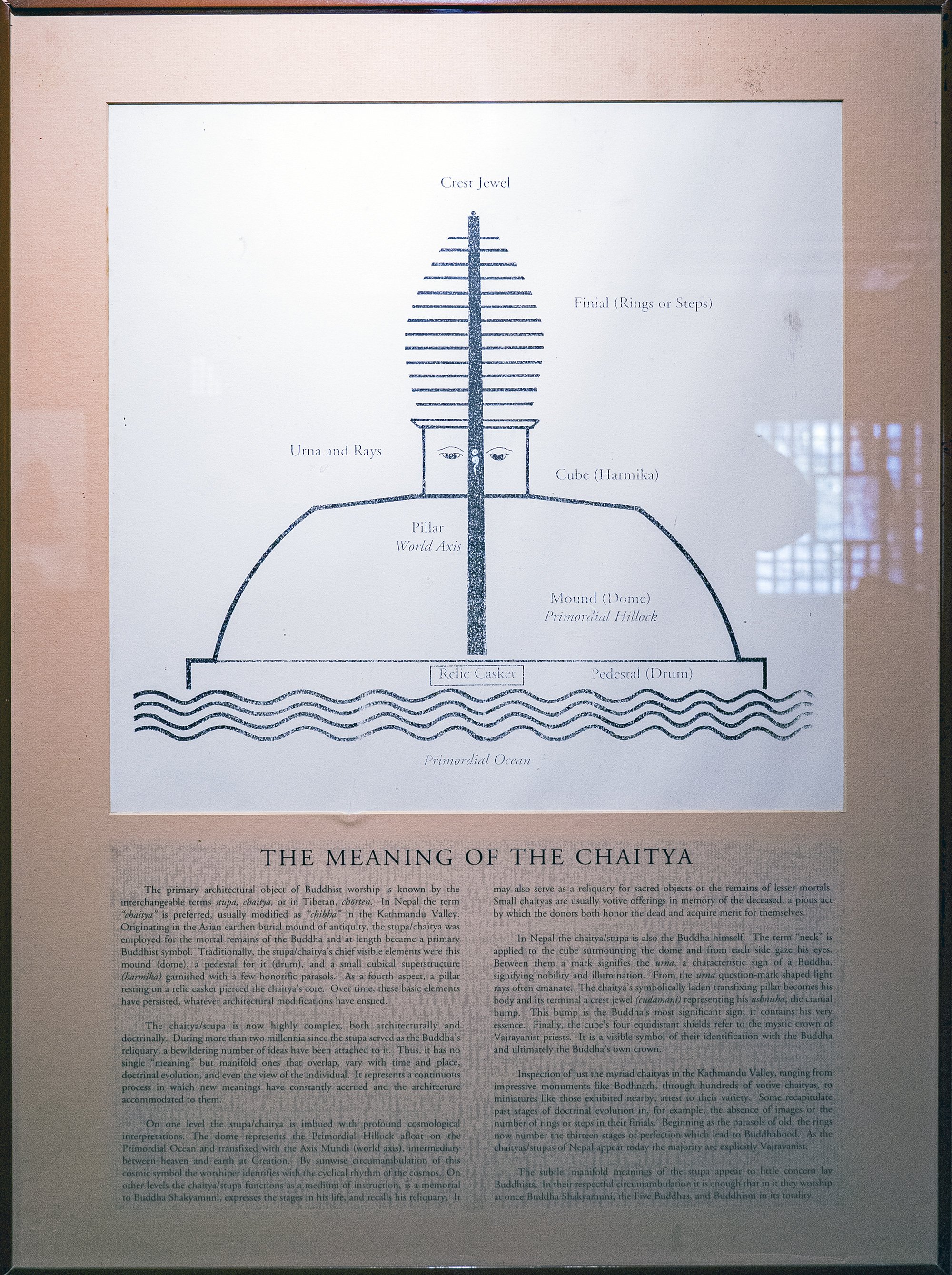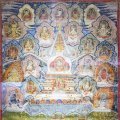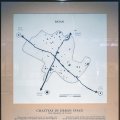Patan Museum (Nepal): photo 118
Photo 118 of 212 in Gallery: Patan Museum (Nepal)

Image title: The meaning of the Chaitya
Description of the photo
The meaning of the Chaitya—The primary architectural object of Buddhist worship is known by the interchangeable terms stupa, chaitya, or in Tibetan, chorten. In Nepal the term “chaitya” is preferred, usually modified as “chibha” in the Kathmandu Valley. Originating in the Asian earthen burial mound of antiquity, the stupa/chaitya was employed for the mortal remains of the Buddha and at length became a primary Buddhist Symbol. Traditionally, the stupa/chaitya’s chief visible elements were this mound (dome), a pedestal for it (drum), and a Small cubical superstructure (harmika) garnished with a few honorific parasols. As a fourth aspect, a pillar resting on a relic casket pierced rhe chaitya’s core. Over time, these basic elements have persisted, whatever architectural modifications have ensued.
The chaitya / stupa is now highly complex, both architecturally and doctrinally. During more than two millennia since the stupa served as rhe Buddha’s reliquary, a bewildering number of ideas have been attached to it. Thus, it has no single “meaning” bur manifold ones that overlap, vary with time and place, doctrinal evolution, arid even the view of the individual. It represents a continuous process in which new meanings have constantly accrued and the architecture accommodated to them.
On one level the stupa/caitya is imbued with profound cosmological interpretations. The dome represents the Primordial Hillock afloat on the Primordial Ocean and transfixed with rhe Axis Mundi (world axis), intermediary between heaven and earth at Creation. By sunwise circumambulation of this cosmic symbol the worshiper identifies with the cyclical rhythm of the cosmos.. On Other levels the chaitya/stupa functions as a medium of instruction, is a memorial to Buddha Shakyamuni, expresses the stages in his life, and recalls his reliquary. It may also serve as a reliquary for sacred objects or the remains of lesser mortals. Small chaityas are usually votive offerings in memory of the deceased, a pious act by which the donors both honor the dead and acquire merit for themselves.
In Nepal the caitya/stupa is also the Buddha himself. The term “neck” is applied to the cube surmounting the dome and from each side gaze his eyes. Between them a mark signifies the urna, a characteristic sign of a Buddha, signifying nobility arid illumination. From the urna question-mark shaped light rays often emanate; The chaitya’s symbolically laden transfixing pillar becomes his body and its terminal a crest jewel (cudamani) representing his ushnisha, the cranial bump. This bump is the Buddha’s most significant sign; it contains his very essence. Finally, the cube’s four equidistant shields refer to the mystic crown of Vajrayanist priests. It is a visible symbol of their identification with the Buddha and ultimately the Buddha’s own crown.
Inspection of just the myriad chaityas in the Kathmandu Valley, ranging from impressive monuments like. Bodhnath, through hundreds of votive chaityas, to miniatures like those exhibited nearby; attest to their variety. Some recapitulate past stages of doctrinal evolution in, for example, the absence of images or the number of rings or steps in their finials. Beginning as rhe parasols of old, the rings now number the thirteen stages of perfection which lead to Buddha-hood. As the chaityas/stupas of Nepal appear today the majority are explicitly Vajrayanist.
The subtle, manifold meanings of the stupa appear to little concern lay Buddhists. In their respectful circumambulation it is enough that in it they worship at once Buddha Shakyamuni, the Five Buddhas, and Buddhism in its totality.
Image Transcription: Crest Jewel; Finial (Rings or Steps); Urna and Rays; Cube (Harmika); Pillar—World Axis; Mound (dome)—Primordial Hillock; Relic Casket; Pedestal (Drum).
Gallery information:
The Patan Museum is located on the Durbar square of Patan (Lalitpur/Lalitapura, Kathmandu, Nepal) which is associated Keshav Narayan Chowk (Keshavnarayan)—a form of Lord Vishnu. Being listed as a World Heritage Site, the whole of Durbar square is filled with exquisite temples, sculptures and other ancient structures, of which the ancient history history can be traced to the Malla Kings of Lalitpur. It is an important site for both Buddhism and Hinduism.
Photo details:
Date: 2019-12-02
Camera: SONY ILCE-6400
Exposure: 1/160
Aperture: f/4
ISO: 640
Focal length: 18mm
High resolution:
Download file
Size: 2.81 MB
Resolution: 2000 x 2679
© Photograph by Gabe Hiemstra.
License: CC BY-NC-ND 4.0

